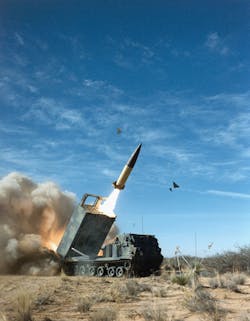REDSTONE ARSENAL, Ala. - U.S. Army fire-support experts are reaching out to industry for help in developing enabling technologies for a long-range tactical missile able to hit stationary and moving targets about 200 or more miles away.
Officials of the Army Contracting Command at Redstone Arsenal, Ala., issued a broad agency announcement (W31P4Q-17-R-0028) for the potential $148 million New and Innovative Technologies for Long Range Fires Technology Development and Demonstration project.
It seeks to develop component and systems-level technologies for a new generation of tactical missiles that can be fired from the Army's Multiple Launch Rocket System (MLRS). The longest-range missile that MLRS can fire today is the Lockheed Martin MGM-140 Army Tactical Missile System (ATACMS), with a maximum range limited to 300 kilometers, or about 189 miles.
The project seeks to enhance the range, precision, and lethality of Army long-range fires against stationary and mobile land and sea targets, at ranges beyond 300 kilo- meters. The Army Contracting Command is issuing the solicitation on behalf of the Weapons Development & Integration Directorate of the Army Aviation & Missile Research, Development & Engineering Center (AMRDEC).
The new long-range tactical missile should be able to function in all operating environments, and be compatible with MLRS launchers "to the greatest extent possible."
At this stage, Army researchers are trying to advance the state of the art in tactical missile inertial navigation; multi-mode seekers; high-temperature seeker dome materials; signature reduction; warheads; digital data links; propulsion; and attitude control. Army experts are asking industry for proposals on new and innovative technologies that focus on one or more of these technical areas.
Inertial navigation involves highly accurate, low-cost inertial sensors that enable precision long-range navigation in environments where reception of global positioning system (GPS) satellite navigation signals are degraded or denied.
Multi-mode seekers involve active and passive seekers that enable target detection, acquisition, tracking, discrimination, and aim-point selection in GPS-degraded or -denied environments.
High-temperature seeker-friendly dome materials should be able to withstand the temperature extremes of extended-range, high-velocity flight profiles, while making the most of radar, infrared sensors, or other kinds of seekers.
Signature-reduction technology involves making these new munitions stealthy and difficult to detect by radar, infrared sensors, or other kinds of target-detection systems.
Warhead technology involves kinetic and non-kinetic ways to enhance lethality with relatively small size, weight, and power consumption (SWaP). Propulsion technology, meanwhile, involves enhanced performance in hybrid, gel, liquid, or air-breathing solid rocket motors for long-range missions.
Digital datalink technology involves communications for integrating smart munitions in a secure battlefield network for synchronizing weapon aim points and arrival times. Attitude-control technology, finally, involves advanced divert thrusters, canards, fins, and jet vanes for improved weapon maneuverability and reduced SWaP.
After these enabling technologies are developed, Army researchers would like to test them together in a sub-scale or full-scale flight test. All technologies developed in this program will be subject to International Traffic in Arms Regulations (ITAR) regulations, and the project is not open to foreign participation at any level.
Army researchers first want concept papers from interested companies, and those submitting the most promising papers will be invited to submit full proposals. Several companies could be chosen to participate in this program with four-year contracts worth between $1 million and $135 million apiece.
Companies interested should e-mail concept papers no later than 24 Oct. 2017 to the Army's Candace Tucker at [email protected], with a copy to Janet Childers at [email protected].

